Communicating Astronomy with the Public (CAP 2018) Goes to Japan
- Details
- Category: GAM 2017 Blog
By Lina Canas, on behalf of the Local Organizing Committee (LOC)
In 2018, the city of Fukuoka, in Japan, will host the largest conference in Astronomy Communication - the Communicating Astronomy with the Public (CAP) Conference, from 24 to 28 March 2018.
 Image I - The organisation has chosen 24 to 28, March 2018 as the dates for the conference, hoping to provide the full Japanese cherry blossom experience to all CAP 2018 participants.
Image I - The organisation has chosen 24 to 28, March 2018 as the dates for the conference, hoping to provide the full Japanese cherry blossom experience to all CAP 2018 participants.
CAP Conference series are organised by the International Astronomical Union (IAU), through Commission 2 - Communicating Astronomy with the Public. The IAU has more than 10,000 active members in 98 countries worldwide, and its mission is to promote and safeguard the science of Astronomy in all its aspects through international cooperation. Since 2003, CAP meetings have facilitated the exchange of ideas and best practices in Astronomy and Space communication and informal education. The Conference helps strengthen the local community of professionals by connecting them to the global network of Astronomy communicators and giving them access to the latest trends; lessons learnt and ongoing projects.
Consolidating the many Japanese efforts made in Astronomy Communication, the National Astronomical Observatory of Japan (NAOJ) and Fukuoka City teamed up to bring the international astronomy outreach and communication community to Japan. CAP 2018 is a call to all Science Communicators; Informal Educators; Professional & Amateurs astronomers; Public Outreach Professionals, Planetarium, Museum & Science Centers Professionals; Natural & Social Science Researchers; Journalists; Writers; Creatives and Artists - to gather in Japan and to share and experience the latest advances in the field. CAP 2018 will be a unique opportunity for meeting new professionals in astronomy communication face-to-face, and strengthen Japanese, Asian-Pacific and international relations.
 Image II - The brand-new Fukuoka City Science Museum on Japan's Kyushu Island has been chosen to receive the conference. The museum will open in October 2017 and will bring science to all Fukuoka’s citizens and visitors. It aims to make science accessible to the public and to provide an environment where children can express their creativity through fun and engaging science experiences.
Image II - The brand-new Fukuoka City Science Museum on Japan's Kyushu Island has been chosen to receive the conference. The museum will open in October 2017 and will bring science to all Fukuoka’s citizens and visitors. It aims to make science accessible to the public and to provide an environment where children can express their creativity through fun and engaging science experiences.
"Communicating Astronomy in Today’s World: Purpose & Methods" is the 2018 Edition theme, and different topics will cover a myriad of key aspects of communicating science in the present and ever changing societies. Ranging from the Current Challenges in Astronomy Communication; Best Practices in Public Outreach; Inclusion, Diversity, Equity and Empathy in Communicating Astronomy; Astronomy Communication for a Better World; Engagement with Astronomy; to the Media’s Role in Astronomy Communication: Using Multimedia, Social Media, Immersive Environments and other Technologies for Public. A Special Topic will be highlighted: Public Engagement Opportunities during the IAU Century Celebration, in preparation for the advent of the IAU 100th year anniversary celebrations in 2019.
CAP Japan will also represent a chance to know more about the cultural multiplicity Japan has to offer - the beautiful surroundings of the conference, the vibrant city of Fukuoka and the Island of Kyushu. We believe that immersing CAP participants in Japanese culture will benefit from a closeness that will reflect in future collaborations and strengthen the bonds with Asia and between themselves.
 Image III - CAP 2018 artwork is profoundly influenced by iconic Astronomy projects depicted in Japanese style drawings. Merging in one piece - the deep Astronomy roots from Japanese culture, to the state of the art high-tech Astronomy endeavours - all under one sky, one planet - celebrating the collaboration and support between the different people of Planet Earth.
Image III - CAP 2018 artwork is profoundly influenced by iconic Astronomy projects depicted in Japanese style drawings. Merging in one piece - the deep Astronomy roots from Japanese culture, to the state of the art high-tech Astronomy endeavours - all under one sky, one planet - celebrating the collaboration and support between the different people of Planet Earth.
We want to thank to Astronomers without Borders for the support since day one to our proposal of hosting CAP 2018 in Japan, and we hope that this collaboration can help to reach the international amateur astronomer's community, highlight and support the amateur astronomers highly impacting role in astronomy outreach around the world.
Registration for CAP 2018 will open on May 1, so please stay tuned for more news, as our team prepares to welcome you to - what we deeply hope! - will truly be a memorable and impacting experience for both the community and astronomy communication.
Official Site:https://www.communicatingastronomy.org/cap2018/
Social Media
https://www.facebook.com/CAPconference/
@CAPconference
 Lina Canas is currently based at National Astronomical Observatory of Japan in Mitaka, Tokyo working for the IAU Office for Astronomy Outreach. Throughout the years she has collaborated with many education and outreach associations in different projects, allowing her to know first-hand that the world is full of amazing people doing amazing things! Many of her hobbies overlap with her work, which sometimes is confusingly fun & confusingly stressing at the same time.
Lina Canas is currently based at National Astronomical Observatory of Japan in Mitaka, Tokyo working for the IAU Office for Astronomy Outreach. Throughout the years she has collaborated with many education and outreach associations in different projects, allowing her to know first-hand that the world is full of amazing people doing amazing things! Many of her hobbies overlap with her work, which sometimes is confusingly fun & confusingly stressing at the same time.
Solar Telescope on the Turquoise Coast
- Details
- Category: GAM 2017 Blog
By Ajay Talwar
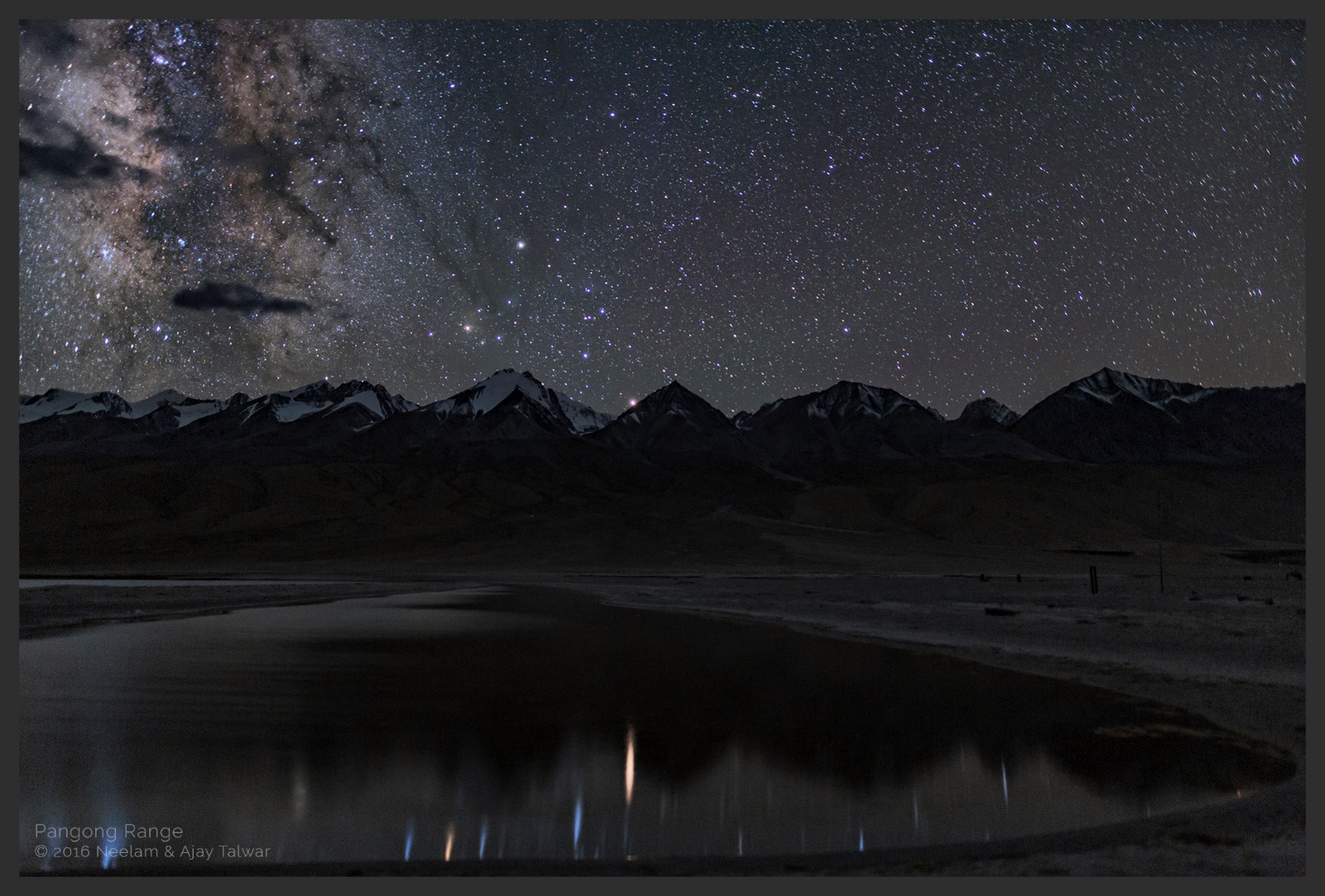
No I am not talking about the thousand kilometres of azure coloured sea coast in the Mediterranean Turkey, but a small lakeside coastline in the Himalayas. The water’s wonderfully clear showing multi-coloured pebbles at the bottom. The water shows different shades of turquoise, aquamarine, cerulean and many other blue hues during the afternoon when the Sun is high. The water turns into brown hues reflecting the surrounding mountains in the evenings. You could spend an entire lazy day watching the Pangong Tso waters change colours by the hour.
 The brackish, salty Pangong is the highest lake in Ladakh, at a height of 4300 metres and is flanked by massive peaks over 6500m high. The lake is 150 km long, but only 4-5 km at its widest. It extends way into Tibet, in fact, only a quarter of the lake is in India.
The brackish, salty Pangong is the highest lake in Ladakh, at a height of 4300 metres and is flanked by massive peaks over 6500m high. The lake is 150 km long, but only 4-5 km at its widest. It extends way into Tibet, in fact, only a quarter of the lake is in India.
Last year in July I spent several days and nights on the banks of Pangong – a lake in two countries. At night this remote place changes into a star studded arena. You simply cannot imaging that the sky could be so chock full of stars. On a moonless night it seems like you can reach out and touch the Milky Way. As you walk on the sandy shore it seems as if the Milky Way at the zenith is casting a shadow walking along and accompanying below you on the sand.
 Normally visitors and tourists to Pangong just make a day trip, Leh- Pangong-Leh. Just about touch the lake at Lukung and head back to Leh. The visitors feel tremendously happy, having reached this remote, and scenic location after crossing a high mountain pass. Seems like a pity since the lake is much more than just a shore at Lukung. Some of the tourists make it further and spend a night at Spangmik or Mann in the seasonal tented camp-hotels at these places. Head further and you reach a village called Merak.
Normally visitors and tourists to Pangong just make a day trip, Leh- Pangong-Leh. Just about touch the lake at Lukung and head back to Leh. The visitors feel tremendously happy, having reached this remote, and scenic location after crossing a high mountain pass. Seems like a pity since the lake is much more than just a shore at Lukung. Some of the tourists make it further and spend a night at Spangmik or Mann in the seasonal tented camp-hotels at these places. Head further and you reach a village called Merak.
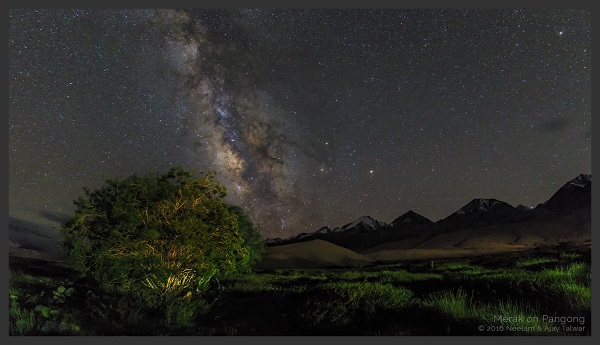
Merak is a beautiful oasis in a vast brownscape of Ladakh. The village is green with farming and square areas of forest plantations. Behind Merak you can see the Pangong range of mountains. The peaks are snow-capped all year round and feed the terrain with many streams. The streams are short and soon make it and feed the Pangong, but on the way sprouting a green oasis. Looking across the Pangong you can see mountains that lie in India and China. The Lake is divided in two countries.
 The Indian Institute of Astrophysics is well underway to install a solar telescope at this beautiful location of Merak. The upcoming telescope has been named ‘National Large Solar Telescope’ or NLST. There have been studies since several years to see if Merak is suitable for the Solar Telescope to be installed here. The site characterisation studies have found that Merak on the Pangong provides good number of sunshine hours with astronomical seeing. The seeing conditions are well suited for a large solar telescope. Plans are being made for a 2 metre solar telescope to be installed at a sandy peninsula jutting into the Pangong. When installed, this will probably be the largest solar telescope in the world. Currently there are couple of small telescopes installed at Merak peninsula, a bunker with computers, and a generator to run all the makeshift instruments.
The Indian Institute of Astrophysics is well underway to install a solar telescope at this beautiful location of Merak. The upcoming telescope has been named ‘National Large Solar Telescope’ or NLST. There have been studies since several years to see if Merak is suitable for the Solar Telescope to be installed here. The site characterisation studies have found that Merak on the Pangong provides good number of sunshine hours with astronomical seeing. The seeing conditions are well suited for a large solar telescope. Plans are being made for a 2 metre solar telescope to be installed at a sandy peninsula jutting into the Pangong. When installed, this will probably be the largest solar telescope in the world. Currently there are couple of small telescopes installed at Merak peninsula, a bunker with computers, and a generator to run all the makeshift instruments.
 During my visit to on the banks of Pangong Tso, I saw Andromeda galaxy rising from the hills plainly visible to the naked eye, billowing clouds, their moving shadows on the brownscape and the wind. Star studded night sky, bullet bikers on their personal epic ride of the life. Rdo Phungs or Tibetan Cairns in airy and sunny places, reflections of stars in the still waters of the lagoon beside the lake, the most perfect turquoise in the Pangong afternoon, beginnings of a grand solar observatory at Merak, the green oasis of Merak in the vast brownscape all around.
During my visit to on the banks of Pangong Tso, I saw Andromeda galaxy rising from the hills plainly visible to the naked eye, billowing clouds, their moving shadows on the brownscape and the wind. Star studded night sky, bullet bikers on their personal epic ride of the life. Rdo Phungs or Tibetan Cairns in airy and sunny places, reflections of stars in the still waters of the lagoon beside the lake, the most perfect turquoise in the Pangong afternoon, beginnings of a grand solar observatory at Merak, the green oasis of Merak in the vast brownscape all around.
At night I heard the roar of the Pangong waves beating against the stones. I also heard streams gently flowing from the melting snow and shortly meeting the lake waters, I saw numerous meteors, blaze across the sky, in their momentary brightness.
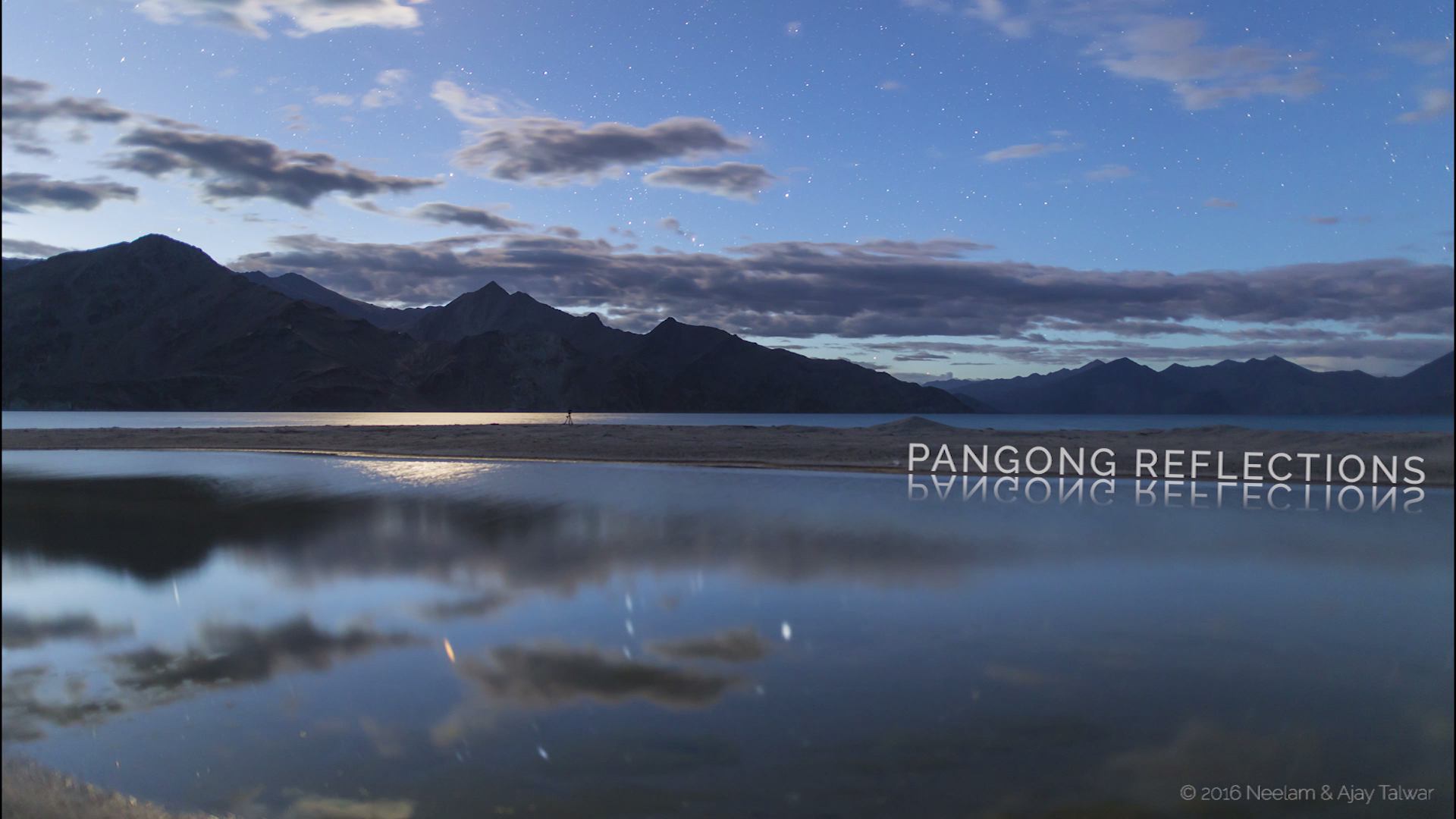
The movie can be seen at this link: https://vimeo.com/196929842
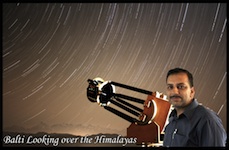 Ajay Talwar took up astrophotography in 1987 during a night when the Moon was occulting the Pleiades. Since then he has continued photographing the skies passionately. He is the most prolific transient sky events photographer in India. One of his early accomplishments was to produce an exhibition of all Messier objects along with three other Indian astrophotographers. Ajay travels with all his astrophotography gear to all across India, especially the Himalayas, places like high altitude Indian Astronomical Observatory at Hanle, Ladakh, high peaks in Himachal Pradesh. His interest to dark skies also take him to the white desert in the northwestern India.
Ajay Talwar took up astrophotography in 1987 during a night when the Moon was occulting the Pleiades. Since then he has continued photographing the skies passionately. He is the most prolific transient sky events photographer in India. One of his early accomplishments was to produce an exhibition of all Messier objects along with three other Indian astrophotographers. Ajay travels with all his astrophotography gear to all across India, especially the Himalayas, places like high altitude Indian Astronomical Observatory at Hanle, Ladakh, high peaks in Himachal Pradesh. His interest to dark skies also take him to the white desert in the northwestern India.
Ajay Talwar regularly holds astrophotography workshops, including practical programs in the Himalayas where participants are provided necessary equipment to photograph the sky.
India is an enormous country of natural and cultural diversity. Through his TWAN contribution Ajay hopes to photograph many of India's heritage under the starry sky.
Ajay is blurring the sharp divide between scientific astrophotography and artistic photo-journalism. In 2011 he was invited to attend a month long residency by the Khoj International Artist’s Association. At the end of ‘Shifting Focus’ his work was exhibited at the Khoj Studios, New Delhi.
An Inclusive GAM 2017
- Details
- Category: GAM 2017 Blog
By Amelia Ortiz-Gil, Lina Canas & Thilina Heenatigala
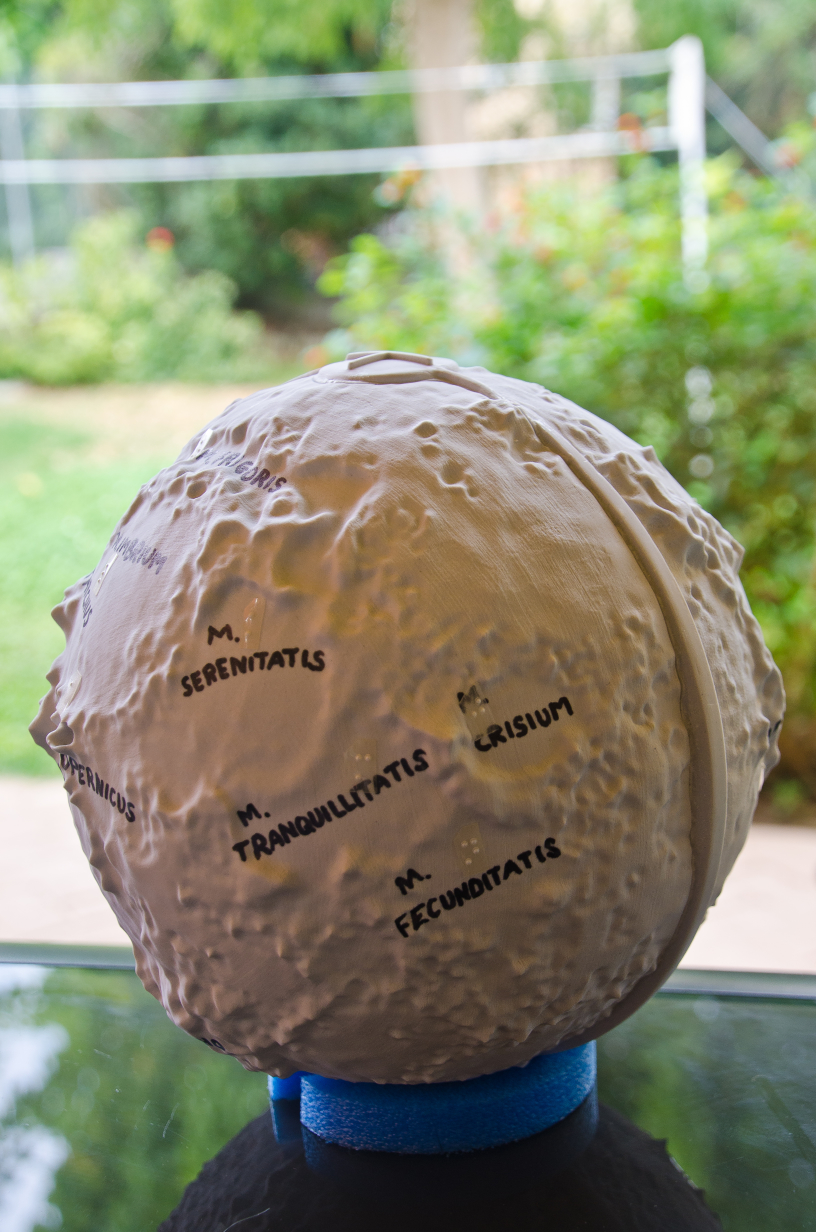 A moon model in 3D with tactile features, high contrast text and braille letters.
A moon model in 3D with tactile features, high contrast text and braille letters.
As you probably know already, the G in GAM stands for Global, meaning everywhere but also everybody. And this year we would like to encourage and help all of you who are organizing events and activities to address them truly to everybody.
All of us are different, but have many things in common, and one of them is the awe that we feel when contemplating or talking about the Universe. The night sky is a gift of nature that appeals to anyone, regardless of age, citizenship, gender, social status, physical condition or cognitive capabilities. Everybody is able to enjoy the cosmos in their own way, which means that communicators, outreach agents and people of the sort have the obligation to make sure that everybody enjoys as much as possible.
In some cases, this might seem very difficult, perhaps even impossible. But, should we agree with Alice when she says “One can’t believe impossible things?” Or will we answer together with the Queen “Why, sometimes I believed as many as six impossible things before breakfast! "? Well, maybe not six but two or three will not do any harm, right? A blind person "seeing" the night sky, or a deaf one "listening" to the radio emission from a pulsar or Jupiter. Can we do that?
It is difficult but not impossible. Technology is advancing pretty fast and there will be more and more aids in the future that will level the playground specially for people with physical special needs. But we also have something even more valuable: human ingenuity. And through carefully thinking and learning how people relate to the environment, and how they receive, perceive and process information we can design activities that will be suitable for most if not all the variety in capacities that a group from the general public can exhibit.
This is technically called the Universal Design for Learning (UDL), which can be applied both to formal and informal instruction. A crude approach to the basics of UDL is to try to convey the information through as many different sensorial channels as possible and to use different tools (texts, images, comics, different kinds of sound, music, etc.), without forgetting the usual communication rules like taking into account the previous knowledge of your public. This benefits everybody, not just people who might have some special needs. The more senses we apply in the learning process the better we remember the contents afterwards, and this applies to anyone regardless of their abilities.
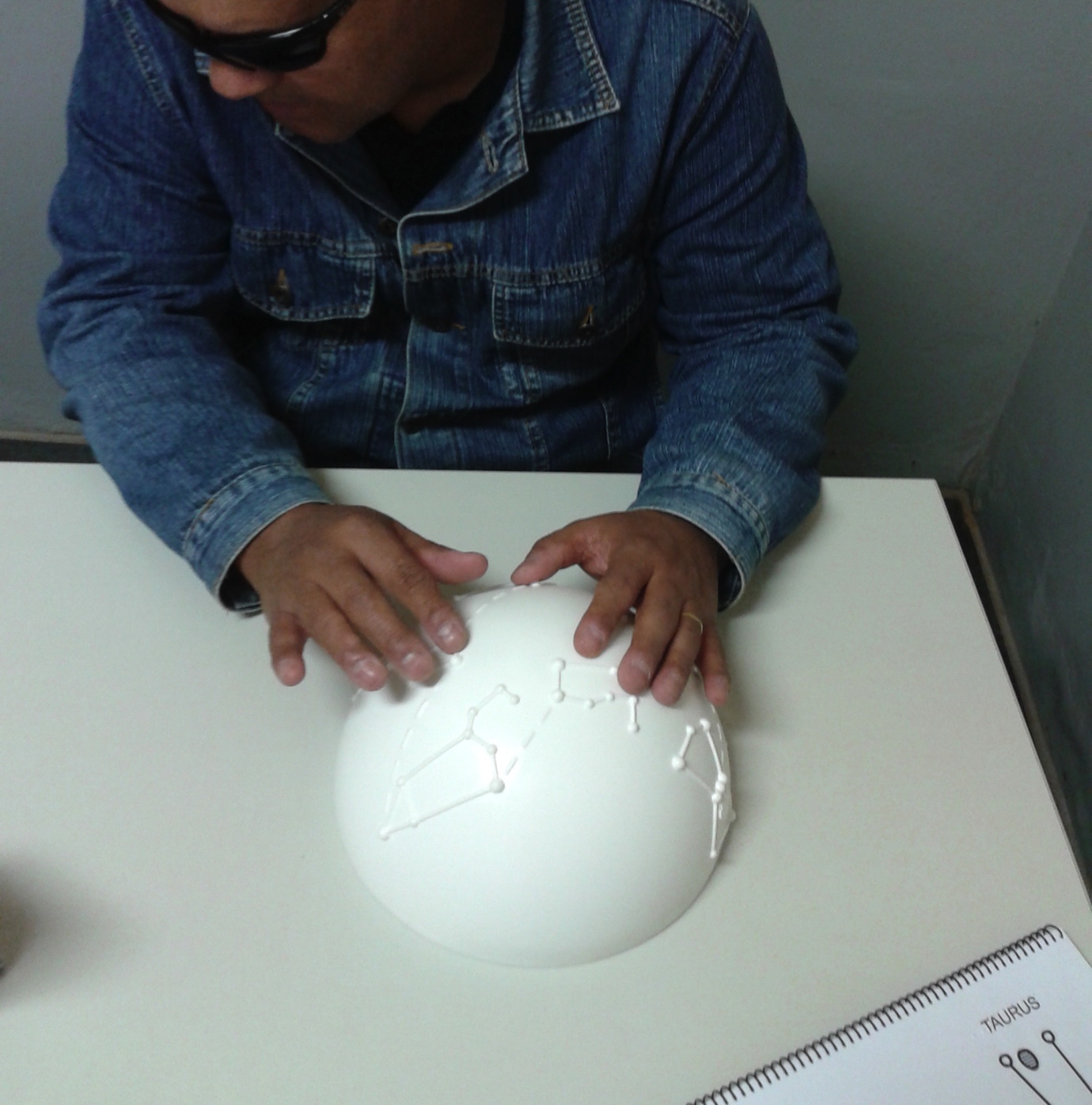 A dome with some northern constellations engraved. This is the tactile support for the planetarium show "The Sky in your Hands".
A dome with some northern constellations engraved. This is the tactile support for the planetarium show "The Sky in your Hands".
Have I convinced you that it is important to include everyone in our activities, and that we can do the 'apparently' impossible things? But you probably still think this is something very difficult to attain. Well, we have some good news!
The International Astronomical Union has recently created a Working Group on Inclusion and Equity, which gathers experts from all over the world who are trying to adapt astronomy to the variety of persons that populate this planet, thinking that no one should be left out. And to help and encourage you to think 'differently' to include everybody, we have teamed up this year with GAM 2017 and we'll be publishing selected resources every day during GAM that is accessible to a public broader than usual, mainly adapted to different kinds of physical needs but equally enjoyable to anyone. For example, it is great to see the Moon but touching its craters, maria and mountains is exciting to persons who are blind and to those with normal vision alike!
So, why not trying one or several of the activities that we are featuring for you during this month? You will also find the keys that will help you make your own accessible activities and events! And if you want to check more of these activities, please visit the repository at the working group's website.
Let's make this GAM 2017 a truly GLOBAL event for all!
 |
Dr. Amelia Ortiz-Gil is an astronomer at the Astronomical Observatory of the University of Valencia, Spain. She is currently working as an Outreach and Public Officer. She coordinated the astronomical activities for disabled people of the Spanish node during the International Year of Astronomy in 2009. Dr. Ortiz-Gil is currently co-chair of AWB's Program for People with Disabilities. |
 |
Lina Canas is currently based at National Astronomical Observatory of Japan in Mitaka, Tokyo working for the IAU Office for Astronomy Outreach. Throughout the years she has collaborated with many education and outreach associations in different projects, allowing her to know first-hand that the world is full of amazing people doing amazing things! Many of her hobbies overlap with her work, which sometimes is confusingly fun & confusingly stressing at the same time. |
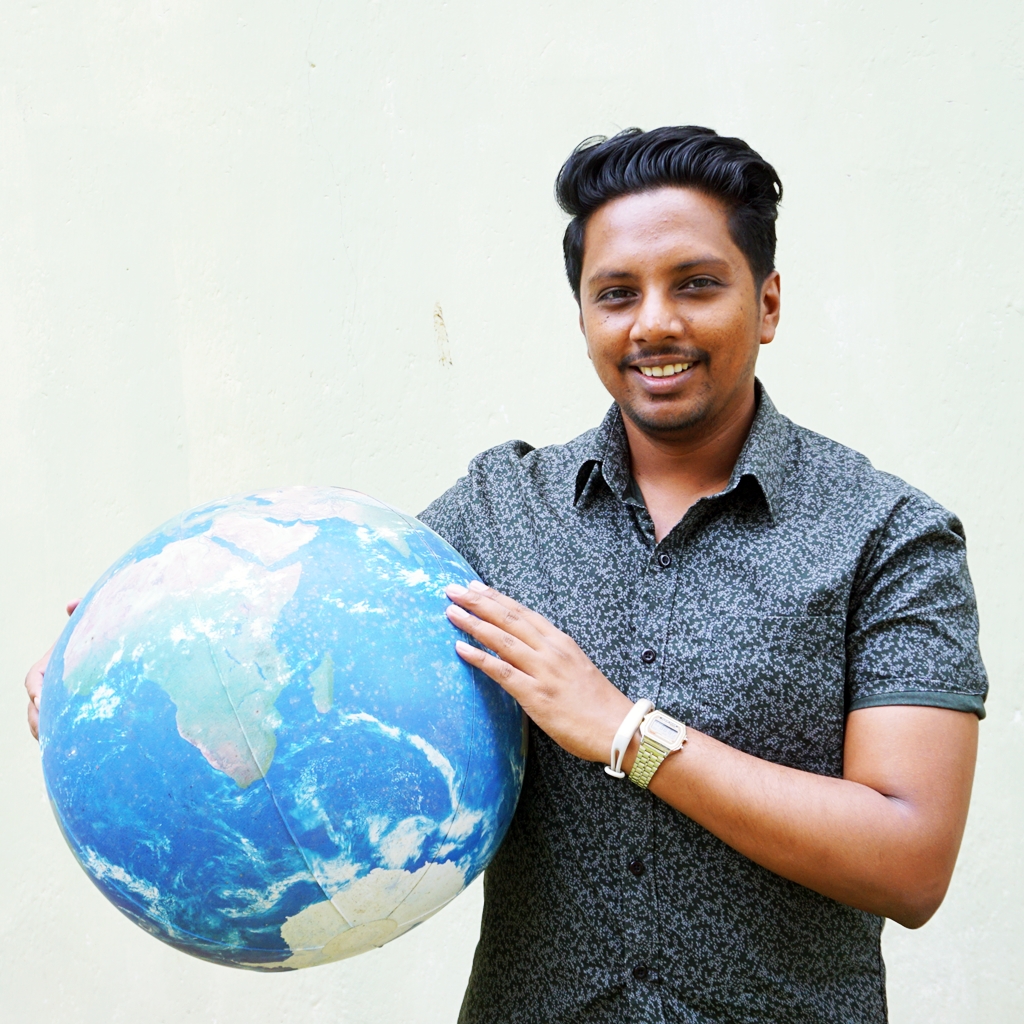 |
Thilina Heenatigala is an astronomy communicator with a focus on developing astronomy education globally. He currently collaborates with NUCLIO, Europlanet and IAU astroEDU at Leiden Observatory. Apart from astronomy, he keeps himself busy with traveling, black & white street photography, and social media storytelling. Follow him on Twitter @ThilinaH https://twitter.com/ThilinaH |
Astronomy for peace: The Columba-Hypatia project
- Details
- Category: GAM 2017 Blog
By Eva Ntormousi

To make the constellation of Columba, the Dutch astronomer Petrus Plancius had to tame one of Orion’s large celestial hunting dogs, the constellation of Canis Major. He chopped off three stars from its tail, and named the new constellation “Dove”, in reference to the bird that brought Noah an olive branch, and hope, after the cataclysm. This small, understated constellation is a symbol of safety after a catastrophe, and survives in popular traditions as synonymous with peace.
Like this inconspicuous constellation, a small outreach initiative with the same name shines in the Southeast Mediterranean: A collaboration between GalileoMobile and the Association for Historical Dialogue and Research (AHDR), the Columba-Hypatia project will bring astronomy to students and teachers in schools throughout Cyprus.
Throughout 2017, Columba will engage the students, the educators, and the general public across the island, in carrying out fun and educational astronomy activities and workshops. Through these activities the goal is to stimulate the students' curiosity about the cosmos and to demonstrate the scientific method and how scientists employ it to discover new things about physics and astronomy.
In this playful process though lies something deeper and even more significant. Astronomy speaks directly to a fundamental human quest, the thirst of knowledge. In inspiring this curiosity in young people, Columba aims to promote interaction, meaningful communication, understanding and, eventually, a culture of peace and nonviolence across borders.
For centuries, Cyprus has been home to two vibrant communities, one Turkish- and one Greek-speaking, that now live divided due to a complex series of political and military conflicts. A remedy to this divide can only come through a continuous and arduous effort, not only from the international community, but most importantly, from the two communities themselves. One such initiative is the inter communal Association for Historical Dialogue and Research, whose mission is to promote historical understanding amongst the public, and more specifically, amongst children and educators.
The other half of the collaboration, GalileoMobile, is an itinerant, science-education initiative that brings astronomy closer to young people around the world. Since its creation in 2008, it has carried out expeditions in Argentina, Bolivia, Brazil, Chile, Colombia, Ecuador, India, Peru and Uganda, as well as extended actions in Portugal, Nepal, and the United States, reaching over 10,000 pupils and 900 teachers. Its vision for a world united “under the same sky” is embraced by the scope and mission of the AHDR. The collaboration between these two entities for the Columba project goes through the prism of a common cultural heritage, and the universality of human curiosity about the Universe.
The activities will mostly take place at the Home for Cooperation, a unique community centre located in the heart of Nicosia, and will comprise, among others, open lectures and star parties for the public. Educational material, including high-quality telescopes, will be donated directly to the visited schools, and the Home for Cooperation will keep additional telescopes, that will be made available to any school that requests them, for years to come!
One might wonder here, can we really make peace just by looking at the stars? Like a poet once said, “it is the gaze that makes the horizon”. Columba-Hypatia says, once we learn how to follow each other’s gaze, we might see the same horizons.

To learn more about Columba and join its activities in Cyprus, you can follow its page on Facebook, here.
The Columba-Hypatia project is funded by the Office for Astronomy for Development of the International Astronomical Union, and benefits from educational material from Meade, Universe Awareness, and ESO.
 Eva Ntormousi is an astrophysicist working at CEA, in France. She received her PhD from the Ludwig-Maximillins University of Munich in 2012. She has been involved in astronomy outreach since 2009.
Eva Ntormousi is an astrophysicist working at CEA, in France. She received her PhD from the Ludwig-Maximillins University of Munich in 2012. She has been involved in astronomy outreach since 2009.
Boundary Conditions
- Details
- Category: GAM 2017 Blog
By Tom Gordon
How do you say it? 'Sorry humanity, we didn't find ET.' 'We are unique and we’ll never know why.'
After centuries of looking for other life forms in our universe, we’ve accepted that being alone is a strong possibility. However it’s still not an easy thing to have to admit. Now we are minutes away after 100’s of years of searching, to having to accept the most depressing answer to the question -
...are we alone in the universe?
Data from one of SETI’s (the search for extraterrestrial intelligence) many projects will be arriving from satellites around the Milky Way Galaxy in 5 minutes and will be instantly analysed. This data will essentially give us a definitive answer to this question.
It’s not an easy feeling. 5 minutes to go, and counting …
From late 1984 and for the next 300 or so years after that, SETI has been looking for intelligent Extra-Terrestrial life. It has been an incredible scientific journey and it is now coming to an end, although not due to a lack of funding. SETI has been well funded for decades due to a renewed interest based on the growing possibility that we may indeed be alone. No matter where in the universe that we have looked so far there have been no signs of life, and the number of places in the universe that life can be found is diminishing.
4 minutes to go …
It is also disappointing and sad to consider that the mission of explaining the origins and nature of life in the universe may never be answered. How do we know this? It has to do with the Drake equation. First proposed by radio astronomer Frank Drake in 1961, the equation calculates the number of communicating civilizations by multiplying several variables and it is our best attempt at estimating the probability of intelligent life in the universe It's usually written:
N = R* . fp . ne . fl . fi . fc . L
- N = The number of civilisations in the Milky Way galaxy whose electromagnetic emissions are detectable
- R* = The rate of formation of stars suitable for the development of intelligent life.
- fp = The fraction of those stars with planetary systems.
- ne = The number of planets, per solar system, with an environment suitable for life.
- fl = The fraction of suitable planets on which life actually appears.
- fi = The fraction of life bearing planets on which intelligent life emerges.
- fc = The fraction of civilizations that develop a technology that releases detectable signs of their existence into space.
- L = The length of time such civilizations release detectable signals into space.
We understand the terms in the Drake Equation and have refined them to acceptable levels with more and more satellites, instrumentation, analytical techniques, and testing.
Over time, as the number of parts of the universe that have been searched increases and the observable universe shrinks, SETI has been able to add a new component to the Drake equation. Now, in less than 4 minutes, this new component will be enough to determine if, N, is undefined or not.
The term extra component in the new Drake equation is a difference between the area of Observable Universe, Ou, and the Searched Universe Su. So the new Drake equation,
N = (R* . fp . ne . fl . fi . fc . L) / (Ou - Su)
is a ratio of what we expect to find divided by what we can physically find.
Back in the 20th Century we learned that the edge of the Universe is expanding faster than the speed of light. We’ve known about this phenomenon for just over 300 years. So our observable universe, or the amount of stuff we could ever see in the universe, is getting smaller. If Ou - Su = 0, then we’ve run out of universe to find ET in, and ….
3 Minutes …
With all the scary social implications aside, SETI has done some really great science. We’ve managed to send satellites and probes further away that we ever thought possible, finding out more about our universe, and us.
One of the coolest projects that SETI was involved in was sending a satellite to return with Voyager 1 to Earth. This was to see if there had been any ET interaction with the furthest satellite we’d sent out. To complete the Voyager project SETI needed to replace Voyager 1. So we sent 2 satellites out, one to bring Voyager 1 back and the other to replace Voyager 1. It was called Voyager 2.0 and has recently, in the last 3 years, reached the Oort cloud. It has returned some fascinating results of course, but we found nothing unexpected on Voyager 1 but none of that seems relevant at the moment.
2 minutes …
What if we DO see evidence for ET? Is humanity ready for that result? I’m not sure if we are. Does it even matter? Even if we find ET they’ll most likely move out of the Observable universe before we have any chance of contacting them. That’s an even bigger announcement. 'Hi humanity. We found ET, but we’re too late'.
1 minute …
Quick, to the observatory
We rush to the SETI observatory control room to be amongst our friends and our supporters in this moment that will define, once and for all our place in the universe. If we are alone who wins? Sure we’ve found something out, but at what cost?
30 Seconds …
If this data shows that there is no ET in this last place in the universe for us to look, we probably have our answer ...
10 Seconds …
People want to know if we’re alone. It matters to us. We’re a species of explorers and always have been. To be told that there’s no-one out there to find might diminish some of us as humans.
5 …
For some strange reason I half expected to get a tap on the shoulder just now, turn around and see an Alien waving at me.
4 …
BOO!
Breathe …
3 …
I’m imagining things.
2 …
This is going to be a big couple of days …
1 …
This is going to be a big rest of humanity ...
The end.
 Tom Gordon is a science communicator at the School of Physics. His role is to provide and develop outreach programs to, mainly, High school students in order to assist them with their studies, provide mentors and information about University life and expectations. In addition, he runs many other School and holiday programs such as Gifted and Talented workshops and he is the Chair of the School of Physics outreach committee.
Tom Gordon is a science communicator at the School of Physics. His role is to provide and develop outreach programs to, mainly, High school students in order to assist them with their studies, provide mentors and information about University life and expectations. In addition, he runs many other School and holiday programs such as Gifted and Talented workshops and he is the Chair of the School of Physics outreach committee.
He did a degree in Astronomy and Astrophysics as well as a Graduate Diploma in Science Communication at the ANU, then a Masters Degree in Space Studies in France. After returning to Australia he was a High School teacher for 4 years in Sydney, and a stint at the National Measurement Institute as a legal metrology policy officer.His role also extends to media enquiries and publications, as well as in-reach to current university students as well as Science Teachers workshops and forums.
In his spare time he is on the executive of the Parents and Citizens committee at his daughters' school and he has also become involved and very interested in the Australian Political process by joining and being active in a minor political party.





